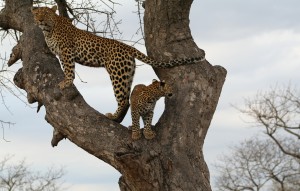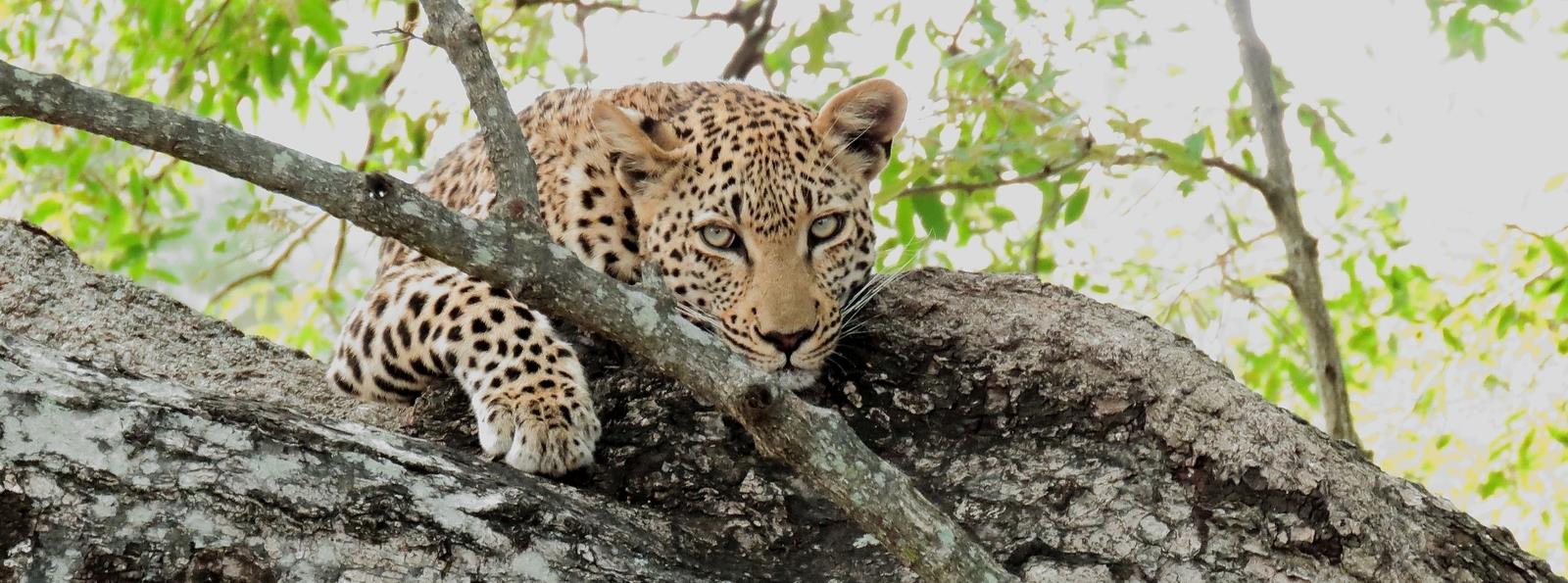The Greater Kruger National Park is the Big Daddy of South Africa safaris, the Godfather of game reserves. Stretching into the horizon across a whopping 2 million hectares of wild African bush, it leaves other game reserves in the dust. Nowhere else can compare. In Kruger, thousands of animals roam the riverine forests, wander across the sun-baked savanna plains and gather around natural waterholes in the twilight. It really is the Africa of your imagination – guaranteed to get your heart thumping, your toes tingling and your camera clicking like crazy.
For many people, a Kruger safari is a once-in-a-lifetime experience – something truly special and totally unrepeatable. All year round, wide-eyed wildlife enthusiasts flock to Kruger in search of the famous Big Five, eager to feel the spirit of safari. Every single sunrise and sunset, open-topped Land Rovers filled with excitable tourists leave the lodges and set off into the heart of the bush on the lookout for lazing leopard, prowling lion and wandering herds of elephant in the dusky light. Such popularity is entirely deserved, so there’s rarely a ‘slow day’ in the Kruger safari calendar.
Kruger really is breathtaking at all times of year, so whether you visit at Christmas, Easter or the height of the English summer holidays, you won’t come away disappointed. However, as an expert insider tip, we can reveal that the most ‘seasoned’ of safari-goers head for Kruger from May to September – the South African winter. The reasons for this range from cost to climate, making perfect sense for both your pocket and your personal comfort.
Here’s a rundown of the rationale behind this safari school of thought. We hope that it will help you take the first steps towards your very own Kruger adventure:
1. WINTER IS ALL ABOUT THE WILDLIFE
If youre an avid animal lover and an eye-popping safari is your holiday priority, May to September is best time to visit Kruger – hands down. Over this period, your Big Five safari will be chock-full of unforgettable wildlife moments to cherish forever after.
 By May, the seasonal rains have passed through the Kruger region and the sun begins to bake the bushveld. During this dry season, which lasts until September, Kruger is a regular wildlife-spotting wonderland. With the African sun beating down every day, the bush quickly thins out, making it far easier to spot leopard in the trees, elephant through the thicket and lion cubs in the grass.
By May, the seasonal rains have passed through the Kruger region and the sun begins to bake the bushveld. During this dry season, which lasts until September, Kruger is a regular wildlife-spotting wonderland. With the African sun beating down every day, the bush quickly thins out, making it far easier to spot leopard in the trees, elephant through the thicket and lion cubs in the grass.
These leopards were photographed in late winter the Sabi Sands Game Reserve area of Greater Kruger, and you can see how the lack of leaves on the tree makes then so much easier to spot.
Without rainfall, the animals are also more dependent on the water sources. Their thirst draws them out of the bush and into to the open. So, from May, the waterholes sprinkled across the reserve become a hub of animal activity at all hours of the day, with zebras, giraffes and elephants all sipping alongside one another. Here, at the waterholes, you can be waiting in your open-topped jeep, full of anticipation with your fully charged camera in hand. We know from personal experience that you won’t come away with an empty SD card!
2. YOUR SAFARI WILL COST MUCH LESS!
Your money will go significantly further if you book a Kruger safari for between May and September, giving you a little extra wiggle room to be a little extra indulgent. After all, if this is a once-in-a-lifetime safari, you may as well do it in style!
As May to September is technically classed as ‘low season’ for international tourism in South Africa, lodge prices quite literally head south for the winter. Every year, there are some amazing deals to be snapped up, with rates at some private game reserves dropping dramatcally and many lodges run ‘Stay 4 Nights – Pay For 3’ special offers.
These discounts are incredible considering that game viewing is actually at its very best over these months. So, from May to September, you’ll get the maximum wildlife experience for the minimum strain on your wallet. What could be better?
3. IT’S JUST COOLER
Winters in Kruger are bright, crisp and dry. Skies are blue, the air is cool and sleeping at night is both cosy and comfortable. In general, the temperature hovers between 9C and 26C, which is perfectly pleasant and a little nippy as night falls. There’s very little humidity in the air and temperatures are more temperate, so this makes for a far less sweaty safari experience!
As rainfall is very low over the winter months, there are also fewer pesky mosquitoes to contend with which really is an added bonus. Not only does it lower the risk of malaria, but it will save on midnight scratching!
Although the early morning game drives can be very chilly, you’ll be snug in your safari jeep with woollies on, a blanket over your knees and a hot coffee between your hands. It’s an epic way to wake up, and your circulation will quickly pick up when you spy a pride of lion in the bush!
4. YOU’LL BE ONE STEP AHEAD OF THE HERD
Although it’s true that Kruger is busy all year round, most international visitors head for South Africa from December to April – the summer of the Southern Hemisphere. During these months, Cape Town is warm and sunny, so it’s perfect for a cosmopolitan beach break and a meander along the Garden Route. Many people choose to top off their trip with a Kruger safari, which explains the holiday hoards at this time of year.
However, Kruger has a totally different climate from Cape Town, so while the summer is sensational in the Cape, the winter is wonderful for wildlife in Kruger. Travelling to Kruger between May and September, you’ll be breaking away from the pack, so you’ll find fewer crowds and fewer Land Rovers at each sighting. This will give your safari a far more exclusive atmosphere.
It’s important to remember that Kruger is equally popular with South Africans who return year on year to its lodges, hills and valleys. By avoiding the main holiday periods and school breaks over Christmas and throughout July, you’ll beat the pack, getting a world-class wildlife experience without the safari swarms.
All in all, May to September really is the season for safari-savvy travellers to Kruger. It’s more exclusive, less expensive and even more exhilarating. The only drawback of travelling to South Africa at this time of year is the weather in Cape Town, which can be a bit grizzly in these months. However, the tropical coastal city of Durban, the stunning Drakensberg Mountains and the historically rich state of KwaZulu Natal will all be crisp and bright, so if you blend Kruger with these sunny spots, you’ll be all set for a brilliant holiday.
Need more convincing? We thought not. Well, it just so happens that now is the perfect time to book your ‘low season’ Kruger safari in 2014! There are some great offers in the offing and the lodges are filling up fast, so it’s best to get a wriggle on with your booking. Just buy your ticket, choose your lodge, hop on a plane, jump in a jeep and keep your camera firmly by your side at all times! Trust us, you won’t regret it.

